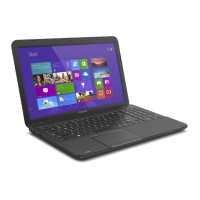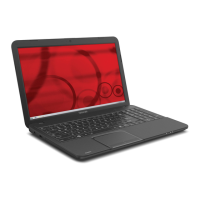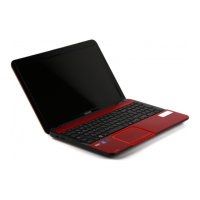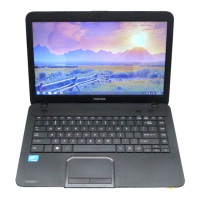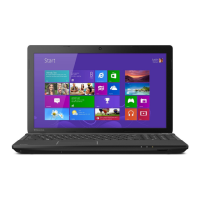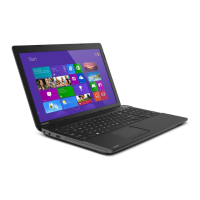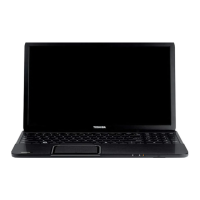
Do you have a question about the Toshiba Satellite C850 Series and is the answer not in the manual?
| RAM | Up to 8GB DDR3 |
|---|---|
| Optical Drive | DVD SuperMulti Drive |
| Wireless | Wi-Fi 802.11 b/g/n |
| LAN | 10/100 Mbps Ethernet |
| Processor | Intel Core i3/i5/i7 |
| Storage | 1TB HDD |
| Display | 15.6-inch HD (1366x768) |
| Graphics | Intel HD Graphics |
| Operating System | Windows 7 |
| Battery | 6-cell Li-ion |
| Weight | 2.3 kg (5.07 lbs) |
| Ports | USB 3.0, USB 2.0, HDMI, VGA |
| Card Reader | SD/SDHC/SDXC |
Information regarding copyright, disclaimer, and trademarks for the manual.
Details on regulatory compliance and declarations.
Specifies approved and unapproved working environments for the computer.
Regulatory compliance information specific to Canada.
Instructions for product disposal valid for EU member states.
Guidelines for proper disposal of batteries and accumulators.
Statement regarding the EU's REACH chemical regulation.
Information regarding product disposal specific to India.
Notice pertaining to video standards and licensing.
Information regarding the OpenSSL toolkit license terms.
Details about the computer's ENERGY STAR compliance and energy efficiency.
Instructions for disposing of the computer and its batteries.
Safety precautions for using the optical disc drive.
General safety and handling precautions for the computer.
Ensuring proper ventilation to prevent overheating.
Recommendations for setting up a suitable computer workspace.
Precautions against physical injuries from computer usage.
Information on potential interference from mobile phones.
Details on wireless device interoperability and cautions.
Information on Wireless LAN compatibility and standards.
Information on Bluetooth compatibility and standards.
Cautions regarding the use and operation of wireless devices.
Information on the health aspects of using wireless devices.
Information on radio frequency regulations.
Restrictions on wireless frequency usage in Europe.
Additional restrictions on wireless frequency usage in Europe.
Regulatory compliance information specific to Canada.
FCC compliance, RF radiation, and interference cautions for USA.
Regulatory compliance information specific to Taiwan.
Taiwanese regulatory article related to radio devices.
Guidelines for using the equipment in Japan.
Key notices for operating equipment in Japan.
Explanation of Wireless LAN indicators.
Explanation of Bluetooth indicators.
Information related to JEITA standards.
Information on device authorization and certification.
List of radio approvals for wireless devices by country/region.
Explanations of legal footnotes and non-applicable icons.
Information on the Central Processing Unit (CPU).
Legal footnotes regarding CPU performance variations.
Information and requirements for 64-bit computing.
Details about the main system memory (RAM).
Information on battery life duration and factors affecting it.
Information on the capacity and definition of Hard Disk Drive.
Details about the Liquid Crystal Display (LCD) screen.
Information about the Graphics Processing Unit (GPU).
Technical specifications for Wireless LAN.
Information on applicable copy protection standards.
Explanation of message types used in the manual.
A checklist of hardware and documentation included with the computer.
Explanation of formats used in the manual for terms and procedures.
Guidance for initial setup and first-time use of the computer.
Instructions for connecting the AC power adaptor.
Instructions on how to open the computer's display panel.
Steps for powering on the computer for the first time.
Guidance on the initial setup process for the operating system.
An introduction to the Windows Start screen interface.
Procedures for shutting down the computer.
Details on how to properly shut down the computer.
Methods for restarting or resetting the computer.
Instructions on how to put the computer into Sleep Mode.
Conditions under which Sleep Mode may not function.
Instructions on how to use Hibernation Mode.
Overview of the computer's front panel when the display is closed.
Explanation of the DC IN/Battery status indicator light.
Description of Power and Wireless communication indicators.
Location and function of the memory media card slot.
Identification of ports and drives on the computer's left side.
Details about the DC IN 19V jack for power connection.
Description of the USB 2.0 port on the left side.
Information about the computer's optical disc drive.
Identification of ports on the computer's right side.
Description of the headphone jack for audio output.
Description of the microphone jack for audio input.
Description of USB ports on the right side.
Details about the HDMI out port for video output.
Description of the LAN jack for network connection.
Details about the external RGB monitor port.
Explanation of the computer's cooling vents.
Information about the security lock slot.
Overview of components located on the back panel.
Details about the computer's rechargeable battery pack.
Overview of components located on the computer's underside.
Overview of the computer's front panel when the display is open.
Information on wireless communication antennas.
Details about the built-in microphone.
Explanation of the Web Camera LED indicator.
Details about the Web Camera functionality.
Information about the computer's display screen.
Instructions for using the power button.
Details about the display panel hinges.
Information about the computer's stereo speakers.
Details about the computer's keyboard.
Instructions for using the Touch Pad.
Description of the Touch Pad control buttons.
Explanation of the LCD Sensor switch function.
Overview of the computer's internal hardware components.
Information on the Central Processing Unit (CPU).
Information on storage devices like HDD and SSD.
Details about the Real Time Clock (RTC) battery.
Information on Video Random Access Memory (VRAM).
Explanation of the display controller's function.
Details on Intel's display power saving technology.
Details on AMD's Vari-Bright display technology.
How to monitor the computer's power and battery status.
Explanation of different power conditions and their indicators.
Detailed explanation of the DC IN/Battery indicator states.
Detailed explanation of the Power indicator states.
Summary of the computer's technical specifications.
Dimensions and physical characteristics of the computer.
Environmental conditions for operating and storing the computer.
Information on the computer's power requirements.
Pin assignment details for the external RGB monitor port.
Information on AC power cords and connectors.
List of certification agencies for power cords and plugs.
Basic operations and features of the computer's keyboard.
Explanation of keyboard indicators like CAPS LOCK and NUM LOCK.
How to use function keys for various computer operations.
Description of special Windows keys on the keyboard.
Method for generating ASCII characters using codes.
Information and usage of optical disc drives.
List of disc formats supported by the drives.
Step-by-step guide for using optical disc drives.
Description of different types of writable discs (CDs, DVDs, Blu-ray).
Instructions and precautions for writing data to discs.
Best practices and warnings for writing or rewriting media.
Information and limitations of the TOSHIBA VIDEO PLAYER software.
Settings and troubleshooting for display devices and audio.
How to start and operate the TOSHIBA VIDEO PLAYER.
Procedure to open the TOSHIBA VIDEO PLAYER manual.
Information and limitations for the TOSHIBA Blu-ray Disc Player.
How to start and operate the TOSHIBA Blu-ray Disc Player.
Features and requirements for 3D playback on external devices.
Crucial safety information for using the 3D function.
Notes on 3D playback features within TOSHIBA VIDEO PLAYER.
Information on the computer's wireless communication capabilities.
Details about Wireless LAN connectivity and settings.
Information on Bluetooth wireless technology and its features.
Instructions for connecting to a Local Area Network (LAN).
Information on LAN cable types and how to connect them.
Information on battery types, use, and handling.
Description of different battery types used in the computer.
Precautions and procedures for caring for and charging the battery.
Methods for monitoring the remaining battery capacity.
Tips and settings to maximize battery operating time.
Estimated time until batteries are exhausted in different modes.
Procedures to maximize the lifespan of battery packs.
Instructions on how to remove and install the battery pack.
Step-by-step guide for removing the battery pack.
Step-by-step guide for installing the battery pack.
Instructions for installing additional system memory modules.
Step-by-step guide for removing a memory module.
Overview of peripheral devices and their functions.
Information about using memory media cards.
Guidelines for formatting and caring for memory media cards.
Instructions for inserting memory media into the slot.
Instructions for removing memory media from the slot.
How to connect an external monitor to the computer.
Step-by-step instructions for connecting the monitor cable.
How to connect an HDMI display device to the computer.
Step-by-step instructions for connecting via the HDMI out port.
Configuring display settings for video output via HDMI.
Procedure to select the display mode for HD content.
Instructions for connecting a security cable to the lock slot.
List of optional accessories available for the computer.
Details on optional Memory Kits and AC Adaptors.
Information on purchasing additional battery packs.
Features related to sound system and video modes.
Adjusting volume levels for speakers and microphones.
Information on SRS sound technology and audio enhancements.
Using the Realtek HD Audio Manager for configuration.
Settings for power management and speaker configuration.
Configuring video mode settings via screen resolution.
Guidelines for handling and cleaning the computer.
Instructions on how to clean the computer's exterior.
Introduction to pre-installed utilities and applications.
Description of the TOSHIBA Desktop Assist utility.
Information on the TOSHIBA PC Diagnostic Tool.
Details on the TOSHIBA Password utility for security.
How to use TOSHIBA System Settings to configure the computer.
Information on the TOSHIBA VIDEO PLAYER software.
Description of the TOSHIBA HDD Accelerator utility.
Information on the TOSHIBA eco Utility for power saving.
Information on the TOSHIBA Blu-ray Disc Player software.
Information on the TOSHIBA Media Player.
Overview of unique or advanced features of TOSHIBA computers.
Features related to keyboard and power management settings.
Features related to USB functionality and audio enhancements.
Features for low battery hibernation and heat dispersal management.
Details on Sleep Mode and Hibernation Mode.
Features for USB wakeup and audio enhancement settings.
Details on the TOSHIBA Password utility for security.
Procedures for setting and managing user passwords.
Procedures for setting and managing supervisor passwords.
How to start the computer when a password is set.
How to use TOSHIBA System Settings to configure the computer.
Steps to access the TOSHIBA System Settings utility.
Description of the TOSHIBA System Settings window interface.
Information on general BIOS settings.
Configuration options for Sleep and Charge functionality.
Enabling/disabling USB charge under battery mode.
Customizing computer display settings.
Selecting the display to use when the computer starts.
Modifying the computer's boot settings.
Setting the priority for boot devices.
Selecting the system boot-up speed.
Configuring the Panel Open - Power On feature.
Setting conditions for the keyboard.
Configuring the Function Keys mode.
Enabling or disabling the Wake-up on Keyboard function.
Configuring USB settings.
Enabling or disabling USB Legacy Emulation.
Enabling or disabling the internal USB 3.0 controller.
Configuring SATA interface settings.
Setting the SATA interface for performance or battery life.
Configuring LAN settings.
Enabling or disabling the Wake-up on LAN feature.
Enabling or disabling the built-in LAN function.
Information and usage of the TOSHIBA Media Player.
Important notes regarding the use of the TOSHIBA Media Player.
How to operate the TOSHIBA Media Player.
Procedure to open the TOSHIBA Media Player manual.
Information on the TOSHIBA PC Health Monitor application.
Methods to start and enable the PC Health Monitor.
Information on system recovery options.
Steps to create recovery media for the system.
How to restore the system from created recovery media.
How to restore the system from the recovery partition.
Guidelines for identifying and analyzing computer problems.
Basic checks to perform before troubleshooting complex issues.
Troubleshooting steps for software-related problems.
Troubleshooting steps for hardware-related problems.
How to handle programs that have stopped responding.
Steps to troubleshoot when the computer fails to start.
Troubleshooting issues with loading startup options.
Checklist for common hardware and system problems.
Troubleshooting issues related to computer power.
Troubleshooting issues with AC power connection and adapter.
Troubleshooting issues related to the computer's battery.
Troubleshooting problems with the Real Time Clock settings.
Troubleshooting issues related to the keyboard.
Steps to resolve garbled display output from the keyboard.
Troubleshooting issues with the internal display panel.
Steps to take when the display shows no output.
Troubleshooting issues with markings on the display panel.
Troubleshooting issues related to the Hard Disk Drive.
Steps to resolve issues booting from the Hard Disk Drive.
Troubleshooting steps for slow Hard Disk Drive performance.
Troubleshooting issues related to the optical disc drive.
Troubleshooting issues accessing discs in the optical drive.
Troubleshooting issues with memory media cards.
Steps to resolve memory media card errors.
Troubleshooting inability to write to a memory card.
Troubleshooting inability to read files from a memory card.
Troubleshooting issues with pointing devices.
Troubleshooting issues related to the Touch Pad.
Steps to resolve when the Touch Pad is not functioning.
Troubleshooting steps for an unresponsive pointer.
Resolving problems with Touch Pad double-tapping speed.
Troubleshooting incorrect pointer speed settings.
Adjusting Touch Pad sensitivity to resolve issues.
Troubleshooting issues with USB mice.
Steps to resolve when the pointer is unresponsive to mouse input.
Troubleshooting mouse double-clicking functionality.
Troubleshooting incorrect mouse pointer speed settings.
Troubleshooting erratic mouse pointer movement.
Troubleshooting issues with USB devices.
Steps to resolve when a USB device is not working.
Troubleshooting problems with the Sleep and Charge function.
Steps to resolve issues using the Sleep and Charge function.
Troubleshooting rapid battery depletion.
Troubleshooting external devices not working with compatible ports.
Troubleshooting issues with the USB Wakeup function.
Troubleshooting issues related to the sound system.
Steps to resolve when no sound is heard from the computer.
Troubleshooting causes of annoying sounds or feedback.
Troubleshooting issues with external monitors.
Steps to resolve when the external monitor does not turn on.
Troubleshooting display errors with external monitors.
Troubleshooting issues with LAN connectivity.
Steps to resolve when unable to access the LAN.
Troubleshooting issues with the Wake-up on LAN function.
Troubleshooting issues with Wireless LAN connectivity.
Steps to resolve when unable to access Wireless LAN.
Troubleshooting issues with Bluetooth connectivity.
Steps to resolve when unable to access a Bluetooth device.
Information on how to obtain technical assistance from TOSHIBA.
Steps to take before contacting TOSHIBA support.
Information on how to contact TOSHIBA technical support.

